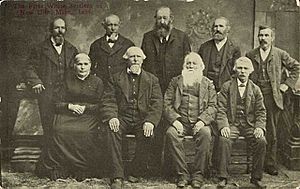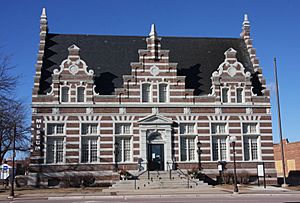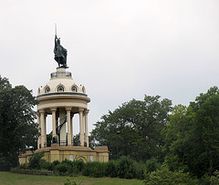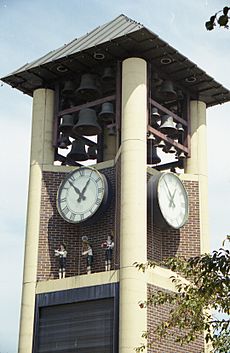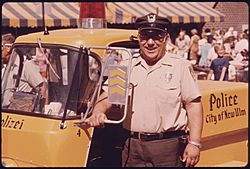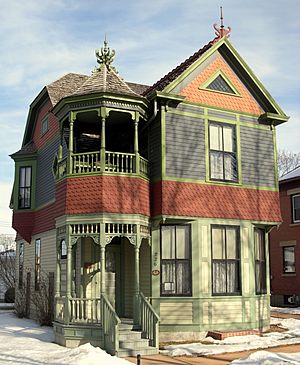New Ulm, Minnesota facts for kids
Quick facts for kids
New Ulm
|
|
|---|---|
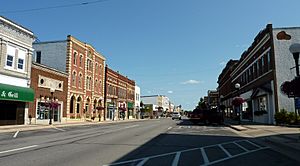
Downtown New Ulm
|
|
| Motto(s):
"A City of Charm And Tradition"
|
|

|
|
| Country | United States |
| State | Minnesota |
| County | Brown |
| Named for | Ulm, Germany |
| Government | |
| • Type | Mayor – Council |
| Area | |
| • Total | 10.29 sq mi (26.66 km2) |
| • Land | 10.16 sq mi (26.31 km2) |
| • Water | 0.14 sq mi (0.36 km2) |
| Elevation | 899 ft (274 m) |
| Population
(2020)
|
|
| • Total | 14,120 |
| • Density | 1,300.91/sq mi (502.26/km2) |
| Time zone | UTC-6 (Central (CST)) |
| • Summer (DST) | UTC-5 (CDT) |
| ZIP code |
56073
|
| Area code(s) | 507 |
| FIPS code | 27-46042 |
| GNIS feature ID | 0648523 |
| Website | ci.new-ulm.mn.us |
New Ulm is a city in Brown County, Minnesota, United States. The population was 14,120 at the 2020 census. It is the county seat of Brown County and is located in the triangle of land formed by the confluence of the Minnesota River and the Cottonwood River.
The city is home to the August Schell Brewing Company, the Hermann Heights Monument, the historic house of former Governor of Minnesota John Lind, and Flandrau State Park. The city is known for the historical role it played in the Dakota War of 1862 with the Battles of New Ulm and its German heritage.
New Ulm is the episcopal see of the Roman Catholic Diocese of New Ulm. The Dakota, original inhabitants of the area, called New Ulm the "Village on the Cottonwood" or Wakzupata. U.S. Highway 14 and Minnesota State Highways 15 and 68 are three of the main routes in the city.
History
Settlement
The city was founded in 1854 by the German Land Company of Chicago. The city was named after the city of Neu-Ulm in the state of Bavaria in southern Germany. Ulm and Neu-Ulm are sister cities, with Ulm being situated on the Baden-Württemberg side and Neu-Ulm on the Bavarian side of the Danube river. In part due to the city's German heritage, it is a center for brewing in the Upper Midwest, home to the August Schell Brewing Company.
In 1856, the Settlement Association of the Socialist Turner Society ("Turners") helped to secure the city's future. The Turners originated in Germany in the first half of the nineteenth century, promoted with the slogan, “Sound Mind, Sound Body.” Their clubs combined gymnastics with lectures and debates about the issues of the day. Following the Revolutions of 1848, substantial numbers of Germans emigrated to the United States. In their new land, Turners formed associations (Vereins) throughout the eastern, midwestern, and western states, making it the largest secular German American organization in the country in the nineteenth century. Following a series of attacks by nativist mobs in major cities such as Chicago, Cincinnati, and Louisville, a national convention of Turners authorized the formation of a colony on the frontier. Intending to begin a community that expressed Turner ideals, the Settlement Association joined the Chicago Germans who had struggled here due to a lack of capital. The Turners supplied that, as well as hundreds of colonizers from the east who arrived in 1856.
As a representation of Turner ideals, the city plan reflected those values. The German Land Company hired Christian Prignitz to complete a new plan for New Ulm, filed in April 1858. This master plan for New Ulm expressed a grand vision of the city’s future. At the heart of the community stood blocks reserved for Turner Hall, the county courthouse, and a public school, representing the political, social, and educational center of the community. The westernmost avenues were named after American heroes George Washington, Benjamin Franklin, Thomas Jefferson, and Thomas Paine—the latter three noted for their freethinking philosophies. Members obtained the means to support themselves — in harmony with nature — through the distribution of four-acre garden lots located outside of the residential area. Historian Dennis Gimmestad wrote, “The founders’ goals created a community persona that sets New Ulm apart from the Minnesota towns founded by land speculators or railroad companies. . . . The New Ulm founders aspired to establish a town with a defined philosophical, economic, and social character.”

U.S.-Dakota War of 1862
In the Dakota War of 1862, the city was attacked twice by Dakota soldiers from nearby reservation on the Minnesota River to the west. Retreating behind barricades that protected the city center, local citizens fought back, supported by volunteer militia who arrived from other towns to support the city's defense. Much of the town outside the barricades was burned.
1881 Tornado
On July 15, 1881, New Ulm was struck by a large tornado that killed 6 and injured 53.
World War I and II
Between the outbreak of World War I in 1914 and America’s entry into the conflict, the citizens of New Ulm closely followed events in Europe, with the local newspapers sometimes printing news from relatives and friends in Germany. In an unofficial referendum in early April 1917, local voters opposed war by a margin of 466 to 19. Even as President Woodrow Wilson prepared his Declaration of War, a Brown County delegation arrived in Washington, D.C., to voice its opposition to that action. On a national level, the Wilson administration organized an active campaign to suppress antiwar fervor, joined on the state level by Minnesota Governor James Burnquist. The Minnesota Commission of Public Safety was granted broad powers to protect the state and assist in the war effort. Specific actions taken by the commission included surveillance of alleged subversive activities, mobilization of opposition to labor unions and strikes, pursuit of draft evaders, and registration and monitoring of aliens. Given the German heritage of New Ulm, federal and state agents began to visit the city soon after America’s entry into the conflict, filing reports to offices in Washington and St. Paul. Locally, several business and civic leaders joined in efforts to root out antiwar fervor. On July 25, 1917, when a massive rally, attended by 10,000 people, was held on the grounds of Turner Hall to, as a flier stated, “enter a protest against sending American soldiers to a foreign country.” Speakers included Louis Fritsche, mayor, Albert Pfaender, city attorney and former minority leader of the Minnesota House of Representatives, Adolph Ackermann, director of Dr. Martin Luther College, and F. H. Retzlaff, a prominent businessman. Federal and state agents mingled through the crowd, gathering information. A month later, Governor Burnquist removed Fritsche and Pfaender from their positions, while the Commission of Public Safety pressured the college to fire Ackermann. These blows sharply divided the community — on one side, many residents took the removals as an attack on the city’s heritage and traditions. Albert Pfaender was the son, and Fritsche, the son-in-law, of the city’s principal founder, Wilhelm Pfaender. On the other side, prominent local businessmen, including flour mill managers, feared economic repercussions and promoted pro-war parades and bond drives.
During World War II, German POWs were housed in a camp to the immediate southeast of New Ulm, in what is now Flandrau State Park. In 1944 a New Ulm family was fined $300 for removing a prisoner from the camp, housing him and taking him to church.
Historic Sites
Turner Hall
New Ulm Turner Hall, with the oldest section constructed in 1873, was listed in the National Register of Historic Places in 1979. It is the oldest Turner Hall in the United States still in its original use. The north half of the building is a combination of exterior wall elements of a 1901 hall/theater that burned in 1952, with a 1953 interior and main facade. Turner Hall remains one of the most active in the country and one that continues its original mission at the same location after more than 150 years. Its Rathskeller is likely the oldest continuously used bar in Minnesota, while its gymnastics program is also the oldest in the state. The Rathskeller features murals of scenes from Germany, painted by Guido Methua (1873), Christian Heller (1887), and Anton Gag (1901). These were recently restored with support from a grant from the Minnesota Historical Society.
The Brown County Historical Society
The Brown County Historical Society, located at 2 North Broadway houses 3 floors of exhibits and one of the largest archives in the state. It contains over 5,500 family files, microfilm of census, naturalization, church, cemetery and birth and death records as well as business and history files. [1]
Defender's Monument
Located at Center and State Streets, Defender's Monument was erected in 1891 by the State of Minnesota to honor the memory of the defenders who aided New Ulm during the Dakota War of 1862. The artwork at the base was created by New Ulm artist Anton Gag. The monument has not been changed since its completion (except for being moved to the middle of the block).
Hermann Monument
The Hermann Monument in New Ulm dominates the Minnesota River valley from a hill overlooking the city. Inspired by a similar monument called Hermannsdenkmal near Detmold, Germany, this figure served as a symbol for members of the Sons of Hermann, a fraternal organization of German Americans. In 1885, the 362 Sons of Hermann lodges across the country committed themselves to the construction of a monument representing their cultural heritage. Through the efforts of Minnesota’s 53 Sons of Hermann lodges, the monument was built in New Ulm, home to many German immigrants. The sculptor chosen for this project was a German sculptor from Ohio, Alfons Pelzer. A delegation from New-Ulm visited Ulm in 2009 and actually went up to the Teutoburger Forest and Detmold in the North of Germany to commemorate the 2000 year anniversary of the Varus battle, when Arminius, a chieftain of the Germanic Cherusci defeated a Roman army in the Battle of the Teutoburg Forest.
German Bohemian monument
A monument to German-Bohemian immigration to America is located in New Ulm. It was erected in 1991 by the German-Bohemian Heritage Society to honor the German-Bohemian immigrants who arrived in this area of the US, most by way of a boat landing on the Minnesota River some 150 yards to the east. The immigrants came mostly from small villages, with the largest number from the village centers of Hostau, Muttersdorf, and Ronsperg. Most of the immigrants were Catholic farmers who spoke a Bohemian dialect of German.
Inscribed in granite slabs around the base of the monument are the surnames of over 350 immigrant families. Many of these names are still prominent in the region. As more and more immigrants arrived, not all of whom could farm, they settled in the city of New Ulm and some of the small communities to the west and north.
The bronze statue that rests on top of the granite base was designed and sculpted by Leopold Hafner, a German-Bohemian sculptor who now lives near Passau, Germany.
The monument is located at 200 North German Street and is open year-round.
Culture
New Ulm has been referred to as the City of Charm and Tradition.
Glockenspiel in Schonlau Park
New Ulm's glockenspiel is one of the world's few free-standing carillon clock towers. It stands 45 feet high, and its largest Bourdon (bell) weighs 595 pounds while the total weight of the bells is two tons. The bells chime the time of day in Westminster style.
Minnesota Music Hall of Fame
In 1962, it was first suggested by the governor that Minnesota develop a museum or Hall of Fame to honor the rich music heritage Minnesota has to offer.
In 1990, New Ulm offered its old library building for the hall of fame site. Owing to the area's ethnic music heritage, the New Ulm was chosen. The Minnesota Music Hall of Fame, Inc. was established with categories reflecting the wide variety of Minnesota's musical heritage.
The museum has displays of music memorabilia for musicians and groups from around the state, including Prince, Judy Garland, Bob Dylan, and local artists Whoopee John Wilfahrt and The Six Fat Dutchmen. The Hall of Fame and museum is located at First North Street and Broadway. In summer the museum is open from Memorial Day through Labor Day each Thursday, Friday and Saturday from 10:00 am until 4:00 pm
Each year in October the museum holds a gala to induct new members into the Hall of Fame, known locally as Minnesota's Grammys.
Polka capital of the nation
Music was always a part of life in New Ulm, especially with the arrival of the musically-inclined German-Bohemians in the 1870s. However, New Ulm took a major leap to national prominence in the 1920s.
Whoopee John Wilfahrt’s successful career opened the door to what became known as “Old-Time” music. After him, other local bands such as those led by Harold Loeffelmacher, Babe Wagner, Elmer Scheid and Fezz Fritsche kept New Ulm well-known around the state and region. They even produced nationally popular recordings.
With the opening of George’s Ballroom and the New Ulm Ballroom and the start of KNUJ radio station in the 1940s, New Ulm billed itself as the "Polka Capital of the Nation". [2] For years New Ulm's famous Polka Days were known worldwide by polka lovers. The festival was held each year in July. Polka Bands played on Minnesota Street and people danced and drank beer until well past midnight.
Festivals
Local events held annually in New Ulm have celebrated the German culture through food, music, and beer. New Ulm's Oktoberfest has been celebrated the first two weekends in October since 1981. Bock Fest, often scheduled concurrently with the local festivities for Fasching, has been celebrated since 1987 at the August Schell Brewing Company. The current summer festival, Bavarian Blast, was created as a recent re-interpretation of New Ulm's longstanding festival, Heritagefest.
In popular culture
New Ulm was the setting and filming location of the 1995 independent film The Toilers and the Wayfarers, directed by Keith Froelich. The city was a filming location for the 2004 documentary American Beer. It is also the setting of the 2009 comedy New in Town, starring Renée Zellweger and Harry Connick Jr., although the movie was actually filmed in Selkirk, Manitoba.
Geography
According to the United States Census Bureau, the city has a total area of 10.26 square miles (26.57 km2), of which, 9.92 square miles (25.69 km2) is land and 0.34 square miles (0.88 km2) is water. The Minnesota River and the Cottonwood River flow past the city on their way to the Mississippi River.
Demographics
| Historical population | |||
|---|---|---|---|
| Census | Pop. | %± | |
| 1860 | 635 | — | |
| 1870 | 1,310 | 106.3% | |
| 1880 | 2,471 | 88.6% | |
| 1890 | 3,741 | 51.4% | |
| 1900 | 5,403 | 44.4% | |
| 1910 | 5,648 | 4.5% | |
| 1920 | 6,745 | 19.4% | |
| 1930 | 7,308 | 8.3% | |
| 1940 | 8,743 | 19.6% | |
| 1950 | 9,348 | 6.9% | |
| 1960 | 11,114 | 18.9% | |
| 1970 | 13,051 | 17.4% | |
| 1980 | 13,755 | 5.4% | |
| 1990 | 13,132 | −4.5% | |
| 2000 | 13,594 | 3.5% | |
| 2010 | 13,522 | −0.5% | |
| 2020 | 14,120 | 4.4% | |
| U.S. Decennial Census | |||
In 2002, the U.S. Census Bureau released a report showing that 65.85% of New Ulm's population has German ancestry, more per capita than any other city in the U.S.
2010 census
As of the census of 2010, there were 13,522 people, 5,732 households, and 3,511 families residing in the city. The population density was 1,363.1 inhabitants per square mile (526.3/km2). There were 5,987 housing units at an average density of 603.5 per square mile (233.0/km2). The racial makeup of the city was 97.8% White, 0.3% African American, 0.1% Native American, 0.7% Asian, 0.4% from other races, and 0.8% from two or more races. Hispanic or Latino of any race were 1.8% of the population.
There were 5,732 households, of which 25.7% had children under the age of 18 living with them, 48.6% were married couples living together, 8.8% had a female householder with no husband present, 3.9% had a male householder with no wife present, and 38.7% were non-families. 33.9% of all households were made up of individuals, and 15.2% had someone living alone who was 65 years of age or older. The average household size was 2.20 and the average family size was 2.80.
The median age in the city was 41.4 years. 20.7% of residents were under the age of 18; 11.7% were between the ages of 18 and 24; 21.6% were from 25 to 44; 27.6% were from 45 to 64; and 18.6% were 65 years of age or older. The gender makeup of the city was 49.1% male and 50.9% female.
Notable people
- Ali Bernard, 2008 Olympic wrestler, born in New Ulm in 1986.
- Joseph Bobleter, newspaper editor, Minnesota legislator, and mayor of New Ulm.
- Kathryn Adams Doty, actress, born in New Ulm in 1920; married to actor Hugh Beaumont of Leave It To Beaver television show fame.
- Marion Downs, audiologist who pioneered newborn hearing screening, born in New Ulm in 1914.
- Robert A. Duin, U.S. Coast Guard Rear Admiral, born in New Ulm in 1924.
- Tony Eckstein, former Minnesota politician, legislator and New Ulm mayor, born in New Ulm in 1923.[3]
- Dennis R. Frederickson, Minnesota state legislator
- Wanda Gág, author and artist, born in New Ulm in 1893. [4] Her childhood home is open to tour.
- Tippi Hedren, film actress, born in New Ulm in 1930; [5] She was the star of Alfred Hitchcock's classic The Birds; mother of actress Melanie Griffith and grandmother of actress Dakota Johnson.
- Harold G. Krieger, Minnesota state senator and judge, born in New Ulm in 1926.
- John Lind, although born in Sweden, immigrated to the United States and called New Ulm his hometown. He was a successful lawyer and the 14th governor of Minnesota [6] from 1899 to 1901. He later served as a United States Congressman from 1903 to 1905.
- Harold Loeffelmacher, polka band leader, born near New Ulm in 1905, organized The Six Fat Dutchmen in New Ulm during the 1930s. [7] His band played polka music all over the United States.
- Brad Lohaus, retired National Basketball Association player, born in New Ulm in 1964.
- William Pfaender, businessman, Minnesota state treasurer, and legislator; served as mayor of New Ulm.
- August Schell moved to New Ulm from Germany in 1848, starting the August Schell Brewing Company. The brewery is still in business today. He died in New Ulm in 1891.
- Flip Schulke, photojournalist who traveled with Martin Luther King Jr.
- Terry Steinbach, former Oakland A's catcher, born in New Ulm in 1962. A three-time All-Star and in 1988 was voted the All-Star Game MVP.
- Thomas O. Streissguth, Minnesota Supreme Court justice.
- Lenore Ulric, actress and movie star, born in New Ulm in 1892.
- Hal Wick, South Dakota state legislator, born in New Ulm in 1944.
- Whoopee John Wilfahrt, born in 1893, on a farm near New Ulm. [8] He became the leader of one of the most successful polka bands in the nation.
See also
 In Spanish: New Ulm (Minnesota) para niños
In Spanish: New Ulm (Minnesota) para niños


